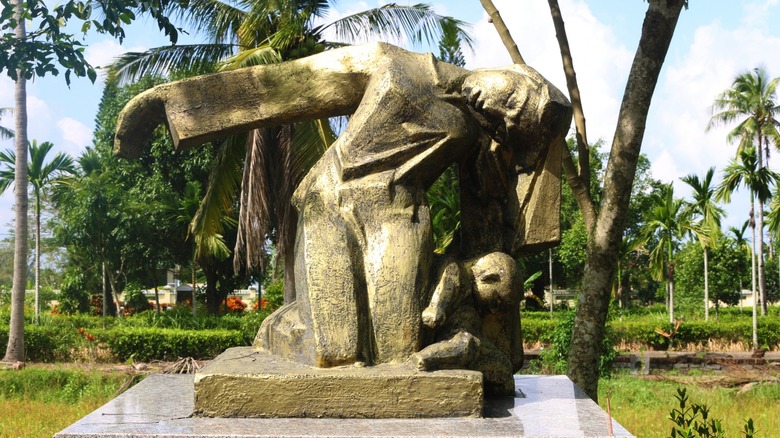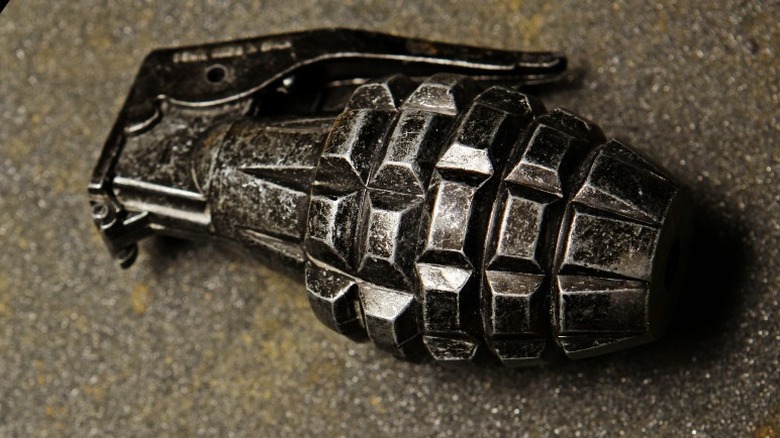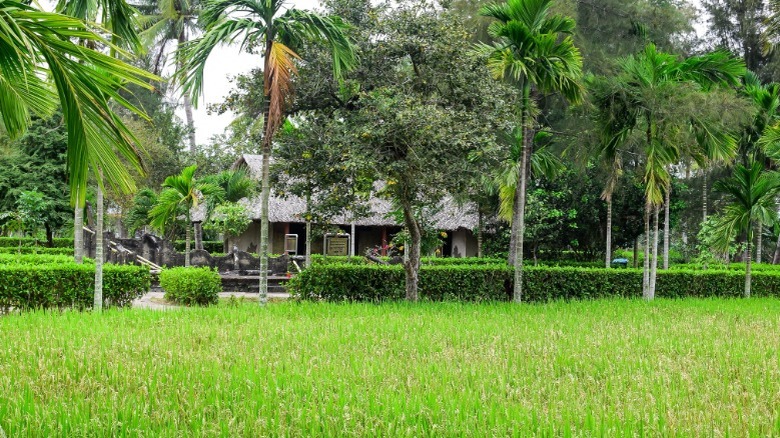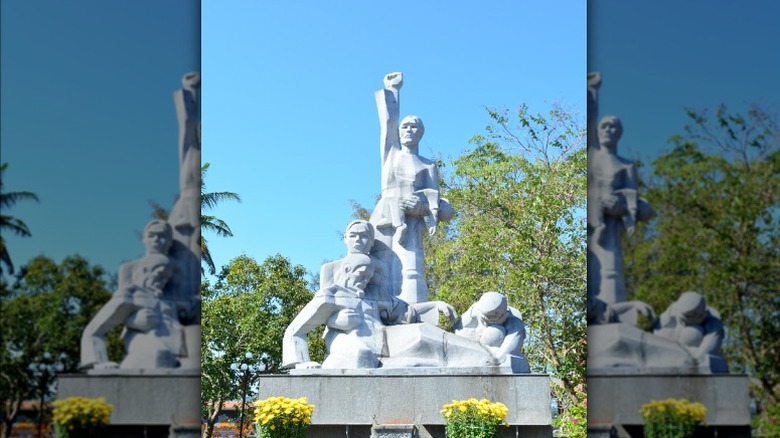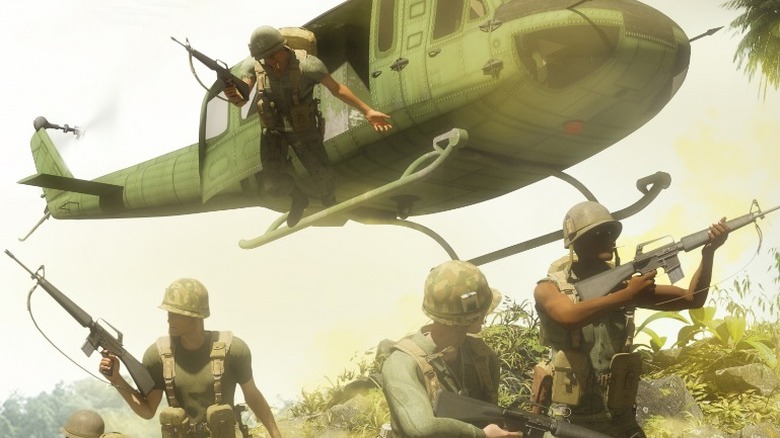Disturbing First-Hand Accounts From The Survivors Of The My Lai Massacre
The following article contains graphic descriptions of violence.
The horrors of war take on many forms, but arguably there are none more crushing than civilian casualties. Virtually every war ever fought has had innocent bloodshed, either the result of collateral damage from combat or ancillary impacts from disease and famine that surfaced afterward. On some occasions, military personnel has brought the war directly to the people, waging wanton acts of violence against unarmed persons. History is full of examples of the latter type of barbarism, with the countless intentional civilian deaths from the likes of the Mongol Horde, the ancient Romans, and others. But war crimes committed against non-combatants are not only in the far reaches of humanity's past. There are plenty of modern examples from all corners of the globe, each one a reminder that we all still have a long way to go to be truly civilized.
The war in Vietnam had its fair share of brutality. Hundreds of thousands of young American soldiers fighting an unwinnable ground war in the hot jungles of Southeast Asia brought out some of the worst in some of those who served. Sexual assault committed by soldiers was not rare, and it sometimes included victims that were fighting on the same side as the aggressors (per Salon).
On March 16, 1968, the soldiers in Charlie Company were sent to a village believed to be controlled by the Vietcong and were expecting a firefight. But when they entered the village at dawn, they encountered a peaceful community made up of mostly women, children, and elderly citizens. The villagers that survived that day told terrifying tales of what they were forced to endure.
Pham Thanh Cong saw most of his family die from a grenade attack
Pham Thanh Cong was only 11 years old the day the soldiers from Charlie Company stormed his village. In an interview with USA Today 50 years later, Cong told of how he was forced inside the dugout where he lived with his family. There, he was surrounded by his mother and four brothers and sisters. Before long, one of the soldiers tossed a grenade inside, not seeming to care that the inhabitants had no weapons or any means to cause harm to the invading force. The explosion injured Cong but took the lives of the five family members that accompanied him. They would be counted among the 504 dead that day.
Decades later, Cong says he still suffers nightmares from the events that day. He lay injured with his dead family members until his father returned to the village and pulled him to safety. Cong can still vividly recall the sight of his 2-year-old sister laid out on a bamboo mat. When the 50th anniversary of the My Lai Massacre approached, Cong told USA Today, "Whenever the anniversary day comes near, I think about her so much. And my heart hurts. This year especially."
One woman was forced to play dead to survive
After waking up on the morning of March 16, Pham Thi Thuan was busy making potatoes for that day's breakfast. Before she could finish, the soldiers began their murderous raid. "They first killed the people at the rice paddies, as well as the cattle," she remembered during a talk with the Deutsche Presse-Agentur news agency (per Al Jazeera). When she first heard gunfire, she thought it was perhaps the South Vietnamese soldiers shooting at pigs or chickens for food. But she was soon rounded up with her neighbors. Thuan and her two young children, aged 3 and 5, were marched to an irrigation ditch and forced to lie down. The troops opened fire with machine guns, taking careful time to see that there were no survivors.
Thuan played dead for what probably felt like an eternity. Somehow, she had survived the hail of gunfire that had riddled the ditch and killed hundreds of her friends and neighbors. Even more miraculous was that she was able to keep her children silent throughout the shooting and its immediate aftermath. The three of them survived, with Thuan recalling what it was like after it was over. "I had to climb over so many bodies. I was crying so much. I wondered what had happened, why we were the only ones left to survive," she told USA Today.
Her youngest daughter still has some memories of her close brush with death. The woman can still remember the screaming from the mouths of the villagers as they were shot. Of the killers, she remembers how some of them were chomping on chewing gum.
One woman found it in her heart to forgive
It might be difficult to fathom the carnage from that day. More than 500 innocent and unarmed civilians were killed at the hands of bloodthirsty soldiers who were acting on savage commands from a superior officer. But villagers sprayed down with gunfire marked only one of the atrocities committed that day. The homes were burned, the livestock slaughtered, and many of the women were sexually assaulted before being executed.
At least one woman from My Lai has found it in her heart to forgive the men who brought destruction with them on that March day in 1968. Cao Thi Do was one of the lucky ones to have been away from the village, visiting another one in the area (via USA Today). When she returned, she was greeted with the burning remnants of the place she knew as home and the bodies of her two children. But despite what was cruelly taken from her that day, she realized that forgiveness was the only way to move on. "I still think always about what happened, but I forgive them," she said years later. "I have to do it for the future. If I keep the hatred, then my children will keep it, and their children. I'm still very sad, but I have to forgive."
The My Lai Massacre from the perspective of an American soldier
After the villagers had been rounded up and their homes searched, the slaughter began. Though some of Charlie Company eagerly followed the orders of their commanding officer, not all were keen on the idea of gunning down unarmed women and children. One member of the army unit there that day recalled how the massacre unfolded and detailed the criminal acts carried out by his brothers in arms.
Sgt. Michael Bernhardt spoke of how there was no resistance from any of the villagers, and not one single shot had been fired on any members of Charlie Company. Despite the absence of aggression toward the U.S. troops, the soldiers went on a bloody rampage. "I saw them shoot an M79 (grenade launcher) into a group of people who were still alive. But it was mostly done with a machine gun. They were shooting women and children just like anybody else," Bernhardt told a reporter (per Cleveland.com). He pointed out that the raids on the villagers' homes produced a handful of weapons — not that there were many there that could have been trained to use them. " I don't remember seeing one military-age male in the entire place, dead or alive," he added.
The slaughter came to an end when army helicopter pilot Hugh Thompson set his aircraft down between the soldiers and the villagers. He and his crew noticed the carnage and threatened to fire on Charlie Company if they didn't cease. "These were infants, 2-, 3-, 4-, 5-year-olds, women, very old men, no draft-age people whatsoever," he said of the victims (per the University of Houston).
The horrors of the massacre are brought to light in the United States
Stories from the massacre began to circulate among the U.S. troops. A year later, an army enlistee named Ron Ridenhour decided that the incident needed to be investigated by a higher authority. He penned a lengthy letter to folks high in the chain of command, including one that landed on the desk of President Richard Nixon. Soon after, a lawyer and writer for The Village Voice contacted journalist Seymour Hersh, urging him to look into a court martial against a low-ranking army officer that was charged with killing Vietnamese civilians (per Harper's). Hersh exhausted himself digging through military records and eventually found himself bringing one of the most harrowing days of the war in Vietnam to light. His efforts earned him the Pulitzer Prize for Journalism.
In all, 14 U.S. military members were charged. But only one man, Lt. William Calley, was ever convicted. Calley was leading the platoon of soldiers that was blamed for most of the deaths that day. Despite the atrocities committed under his command, Calley was let off lightly. The disgraced officer was found guilty of murdering civilians and given a life sentence, which was reduced to only 20 years when Calley took his case to the Military Court of Appeals. Ultimately, he had to serve only four years of his sentence. In 1974, Calley received parole ordered by President Nixon.
If you or anyone you know has been a victim of sexual assault, help is available. Visit the Rape, Abuse & Incest National Network website or contact RAINN's National Helpline at 1-800-656-HOPE (4673).
